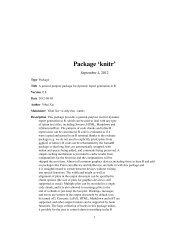Package 'openair'
Package 'openair'
Package 'openair'
Create successful ePaper yourself
Turn your PDF publications into a flip-book with our unique Google optimized e-Paper software.
TheilSen 119avg.timestatisticpercentiledata.threshalphaType can be up length two e.g. type = c("season", "weekday") will producea 2x2 plot split by season and day of the week. Note, when two types areprovided the first forms the columns and the second the rows.Can be “month” (the default), “season” or “year”. Determines the time overwhich data should be averaged. Note that for “year”, six or more years arerequired. For “season” the data are split up into spring: March, April, May etc.Note that December is considered as belonging to winter of the following year.Statistic used for calculating monthly values. Default is “mean”, but can also be“percentile”. See timeAverage for more details.Single percentile value to use if statistic = "percentile" is chosen.The data capture threshold to use ( when aggregating the data using avg.time.A value of zero means that all available data will be used in a particular periodregardless if of the number of values available. Conversely, a value of 100 willmean that all data will need to be present for the average to be calculated, else itis recorded as NA.For the confidence interval calculations of the slope. The default is 0.05. Toshow 99% confidence intervals for the value of the trend, choose alpha = 0.01etc.dec.place The number of decimal places to display the trend estimate at. The default is 2.xlablab.fraclab.cexx.relationy.relationdata.colline.coltext.colcolsauto.textautocorslope.percentx-axis label, by default "year".Fraction along the y-axis that the trend information should be printed at, default0.99.Size of text for trend information.This determines how the x-axis scale is plotted. “same” ensures all panels usethe same scale and “free” will use panel-specfic scales. The latter is a usefulsetting when plotting data with very different values.This determines how the y-axis scale is plotted. “same” ensures all panels usethe same scale and “free” will use panel-specfic scales. The latter is a usefulsetting when plotting data with very different values.Colour name for the dataColour name for the slope and uncertainty estimatesColour name for the slope/uncertainty numeric estimatesPredefined colour scheme, currently only enabled for "greyscale".Either TRUE (default) or FALSE. If TRUE titles and axis labels will automaticallytry and format pollutant names and units properly e.g. by subscripting the ‘2’ inNO2.Should autocorrelation be considered in the trend uncertainty estimates? Thedefault is FALSE. Generally, accounting for autocorrelation increases the uncertaintyof the trend estimate — sometimes by a large amount.Should the slope and the slope uncertainties be expressed as a percentage changeper year? The default is FALSE and the slope is expressed as an average units/yearchange e.g. ppb. Percentage changes can often be confusing and should beclearly defined. Here the percentage change is expressed as 100 * (C.end/C.start
















